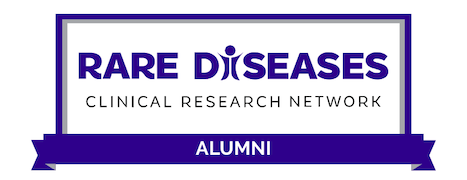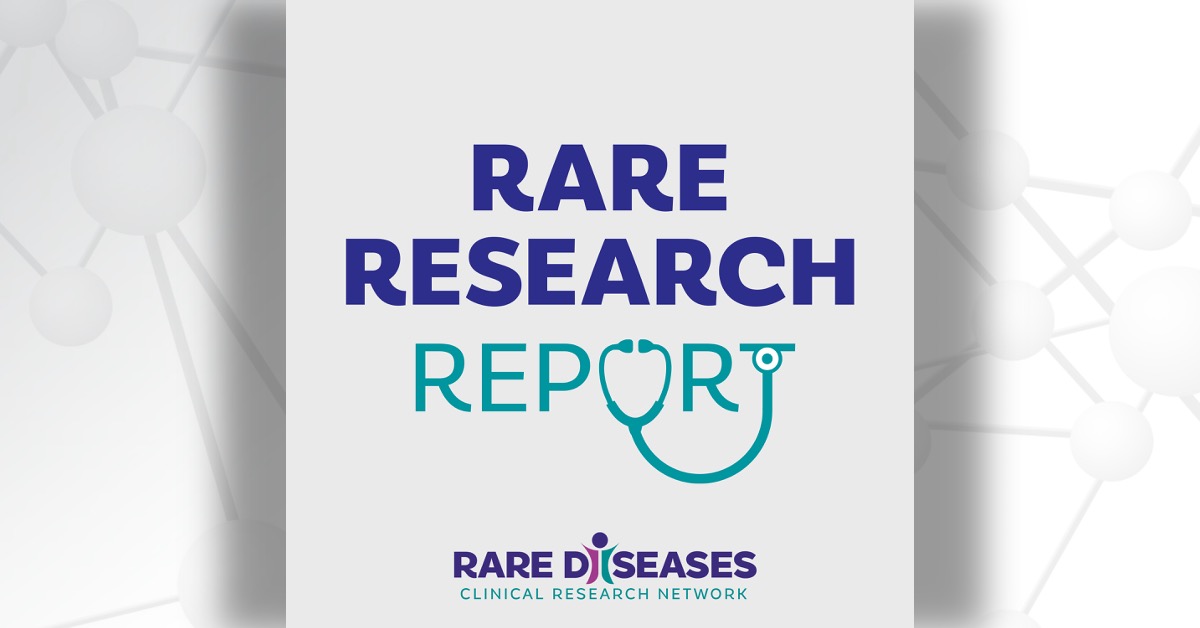Each month, we share summaries of recent Rare Diseases Clinical Research Network (RDCRN) grant-funded publications. Catch up on the latest RDCRN research below.
Jump to:
- Consortium of Eosinophilic Gastrointestinal Disease Researchers (CEGIR)
- Dystonia Coalition (DC)
- Myasthenia Gravis Rare Disease Network (MGNet)
- North American Mitochondrial Disease Consortium (NAMDC)
- Primary Immune Deficiency Treatment Consortium (PIDTC)
Listen to these summaries on the Rare Research Report podcast.
Consortium of Eosinophilic Gastrointestinal Disease Researchers (CEGIR)
Characterizing Variants of Eosinophilic Esophagitis
Eosinophilic esophagitis (EoE) is a chronic inflammatory disorder characterized by the buildup of eosinophils, a type of white blood cell, in the esophagus. Increasingly, patients are presenting with symptoms resembling EoE while having low eosinophil counts.
In this study, researchers aimed to characterize and classify this group of patients. The team used clinical, histological, and molecular analyses to study 69 patients with EoE variants. Within this group, three histological subtypes of EoE were identified and characterized.
Authors note that despite the absence of eosinophils in the esophagus, all EoE variants are active conditions. These variants are part of a disease spectrum, with classical EoE representing the most common form.
Greuter T, Straumann A, Fernandez-Marrero Y, Germic N, Hosseini A, Yousefi S, Simon D, Collins MH, Bussmann C, Chehade M, Dellon ES, Furuta GT, Gonsalves N, Hirano I, Moawad FJ, Biedermann L, Safroneeva E, Schoepfer AM, Simon HU. Characterization of eosinophilic esophagitis variants by clinical, histological, and molecular analyses: A cross-sectional multi-center study. Allergy. 2022 Aug;77(8):2520-2533. doi: 10.1111/all.15233. Epub 2022 Feb 17. PMID: 35094416.
Exploring Risk Factors for SARS-CoV-2 in Children with Asthma and Allergy
Children and people with asthma or other allergic diseases are typically known as high-risk groups for many respiratory viruses. However, it is currently unknown whether these groups are at increased risk for severe acute respiratory syndrome virus 2 (SARS-CoV-2) infection.
In this study, researchers aimed to determine the incidence of SARS-CoV-2 infection in households with children, as well as whether self-reported asthma or other allergic diseases are associated with infection and household transmission. Participants included allergic disease patients from the Consortium of Eosinophilic Gastrointestinal Disease Researchers (CEGIR), which provided an accessible cohort for the study.
For six months, the team collected biweekly nasal swabs and weekly surveys to calculate the probabilities of infection and transmission. Researchers then used regression analyses to determine associated risk factors.
Results suggest that asthma does not increase the risk of SARS-CoV-2 infection. Food allergy was associated with lower infection risk, while body mass index was associated with increased infection risk. Authors note that understanding how these factors modify infection risk may offer new avenues for preventing infection.
Seibold MA, Moore CM, Everman JL, Williams BJM, Nolin JD, Fairbanks-Mahnke A, Plender EG, Patel BB, Arbes SJ, Bacharier LB, Bendixsen CG, Calatroni A, Camargo CA Jr, Dupont WD, Furuta GT, Gebretsadik T, Gruchalla RS, Gupta RS, Khurana Hershey GK, Murrison LB, Jackson DJ, Johnson CC, Kattan M, Liu AH, Lussier SJ, O'Connor GT, Rivera-Spoljaric K, Phipatanakul W, Rothenberg ME, Seroogy CM, Teach SJ, Zoratti EM, Togias A, Fulkerson PC, Hartert TV; HEROS study team. Risk factors for SARS-CoV-2 infection and transmission in households with children with asthma and allergy: A prospective surveillance study. J Allergy Clin Immunol. 2022 Aug;150(2):302-311. doi: 10.1016/j.jaci.2022.05.014. Epub 2022 Jun 1. PMID: 35660376; PMCID: PMC9155183.
Updating Terminology for Eosinophilic Gastrointestinal Diseases
Eosinophilic gastrointestinal diseases (EGIDs) are a group of chronic immune system disorders in which a type of white blood cell (eosinophils) build up in the gastrointestinal tract, causing inflammation or injury. Consensus recommendations have been developed for diagnosis of eosinophilic esophagitis (EoE), the most common EGID. However, there are currently no consensus guidelines for diagnosis of non-EoE EGIDs. Standardization of EGID terminology is one of the first priorities for developing these guidelines.
In this study, a large group of researchers and clinicians aimed to reach international consensus for EGID nomenclature. The team used multiple rounds of surveys to develop a new tiered framework for EGID terms.
Authors note that this revision of terms could advance both clinical care and research in EGIDs. Next steps include selection of specific disease markers and thresholds, definition of symptoms, exclusion of alternative diagnoses, and duration of disease.
Wright BL, Schwartz JT, Ruffner MA, Furuta GT, Gonsalves N, Dellon ES, Aceves SS. Eosinophilic gastrointestinal diseases make a name for themselves: A new consensus statement with updated nomenclature. J Allergy Clin Immunol. 2022 Aug;150(2):291-293. doi: 10.1016/j.jaci.2022.05.012. Epub 2022 May 29. PMID: 35649464; PMCID: PMC9378528.
Dystonia Coalition (DC)
Developing Specific Recommendations for Diagnosis and Classification of Blepharospasm
Blepharospasm is a rare disorder characterized by spasms of muscles surrounding both eyes with excessive blinking and squinting. It is the second most common form of dystonia (involuntary muscle twitching) and often spreads to other regions of the body. Currently, guidelines for diagnosis and classification are ambiguous.
In this study, researchers aimed to provide more specific recommendations for diagnosis and classification of blepharospasm. Data were obtained from the Dystonia Coalition for patients diagnosed with all types of isolated dystonia. The team evaluated these data to determine how examinations recorded by movement disorder specialists were used to classify blepharospasm as focal, segmental, or multifocal.
Results showed much variability in expert opinion regarding the diagnosis of blepharospasm, which was often inconsistent with existing guidelines for the diagnosis and classification of focal blepharospasm. This study highlights the need for more specific guidelines, which are provided in the publication.
Kilic-Berkmen G, Defazio G, Hallett M, Berardelli A, Ferrazzano G, Belvisi D, Klein C, Bäumer T, Weissbach A, Perlmutter JS, Feuerstein J, Jinnah HA; Dystonia Coalition Investigators. Diagnosis and classification of blepharospasm: Recommendations based on empirical evidence. J Neurol Sci. 2022 Aug 15;439:120319. doi: 10.1016/j.jns.2022.120319. Epub 2022 Jun 10. PMID: 35716653; PMCID: PMC9357089.
Exploring Phenotypic Diversity and Shared Mechanisms Across the Dystonias
The dystonias are a group of movement disorders characterized by uncontrollable, sometimes painful, involuntary muscle contractions, resulting in repetitive shaking, turning, and twisting of affected body parts. As new genetic causes continue to be discovered, researchers have found that these different genetic forms share unexpectedly common underlying mechanisms.
In this review article, authors explore the phenotypic diversity and shared mechanisms across dystonia syndromes. They also describe how these mechanisms can give rise to motor performance dysfunctions with a clinical aspect of dystonia.
Authors state that this relationship between dystonia genes could revolutionize current dystonia classification systems. In the future, these advances could have promising effects on mechanism-based therapeutic approaches.
Di Fonzo A, Albanese A, Jinnah HA. The apparent paradox of phenotypic diversity and shared mechanisms across dystonia syndromes. Curr Opin Neurol. 2022 Aug 1;35(4):502-509. doi: 10.1097/WCO.0000000000001076. Epub 2022 Jul 5. PMID: 35856917; PMCID: PMC9309988.
Myasthenia Gravis Rare Disease Network (MGNet)
Review Highlights Recent Insights on the Development of Autoimmune Myasthenia Gravis
Myasthenia gravis (MG) is a neuromuscular disorder caused by an autoimmune response which blocks or damages acetylcholine receptors in muscles. Affected receptors cannot properly receive nerve signals, impacting voluntary muscle contractions. Generalized muscle weakness and fatigue with prolonged activity are characteristic symptoms, which improve with rest.
In this review article, authors summarize recent insights into the development of MG relating to the immune system, including the mechanisms of various MG disease subtypes. They also describe the wide range of treatment options now available to patients with MG, which have uncovered significant differences in clinical responses between subtypes. These differences could help clinicians choose specific therapeutic strategies.
Authors conclude that improved understanding of autoantibodies is revealing the mechanisms that guide the development of MG. In the future, authors note that studies on the differences in immunology among MG patients will be key to developing effective, individualized therapies.
Masi G, O'Connor KC. Novel pathophysiological insights in autoimmune myasthenia gravis. Curr Opin Neurol. 2022 Aug 5. doi: 10.1097/WCO.0000000000001088. Epub ahead of print. PMID: 35942663.
North American Mitochondrial Disease Consortium (NAMDC)
Pyruvate dehydrogenase complex (PDC) deficiency is a rare mitochondrial neurometabolic disorder of energy deficit and a major cause of primary lactic acidemia, where lactic acid builds up in the bloodstream and results in serious health complications. The E1 component of the multienzyme PDC (PDC-E1) is a symmetric dimer of heterodimers encoded by the PDHA1 and PDHB genes. Mutations in PDHA1, encoding the E1α component of E1, are the most common cause of PDC deficiency. Currently, therapeutic options for PDC deficiency are limited.
In this study, researchers performed molecular dynamics simulations of PDC-E1 variants with E1α disease-causing missense mutations. The team evaluated dynamics changes resulting from E1α disease-causing amino acid replacements and examined the implications on PDC-E1.
Results give new insights on how these disease-causing missense mutations affect PDC-E1 structure and function. Authors note that these insights could lead to the development of new gene-specific target-based therapeutics for PDC deficiency.
Gokcan H, Bedoyan JK, Isayev O. Simulations of Pathogenic E1α Variants: Allostery and Impact on Pyruvate Dehydrogenase Complex-E1 Structure and Function. J Chem Inf Model. 2022 Jul 25;62(14):3463-3475. doi: 10.1021/acs.jcim.2c00630. Epub 2022 Jul 7. PMID: 35797142; PMCID: PMC9329271.
Primary Immune Deficiency Treatment Consortium (PIDTC)
CD40 ligand (CD40L) deficiency is a rare X-linked immunodeficiency disorder that leads to recurrent bacterial infections. Not much is known about the immune status of CD40L-deficient carriers, or possible outcomes of hematopoietic stem cell transplantation (HSCT) using these carriers as donors for CD40L-deficient patients.
In this study, researchers evaluated the immune profiles of 7 carriers—including 4 who acted as HSCT donors for family members with CD40L deficiency—and characterized their HSCT outcomes. Results show that most carriers with CD40L deficiency have a normal immune profile with differential high CD40L expression in circulating T follicular helper (cTfh) cells, which are critical for immune response. The team also reported excellent long-term immune reconstitution in CD40L-deficient patients after HSCT using carrier donors.
Authors state that HSCT using X-linked carriers seems to be safe and results in excellent outcomes. Authors also note that this decision should be individualized and driven by the biology of the disease.
Chandrakasan S, Chandra S, Prince C, Kobrynski LJ, Lucas L, Patel K, Walter J, Buckley RH, Meisel R, Ghosh S, Parikh SH. HSCT using carrier donors for CD40L deficiency results in excellent immune function and higher CD40L expression in cTfh. Blood Adv. 2022 Jun 28;6(12):3751-3755. doi: 10.1182/bloodadvances.2021006905. PMID: 35443026.
The Rare Diseases Clinical Research Network (RDCRN) is funded by the National Institutes of Health (NIH) and led by the National Center for Advancing Translational Sciences (NCATS) through its Division of Rare Diseases Research Innovation (DRDRI). Now in its fourth five-year funding cycle, RDCRN is a partnership with funding and programmatic support provided by Institutes, Centers, and Offices across NIH, including the National Institute of Neurological Disorders and Stroke, the National Institute of Allergy and Infectious Diseases, the National Institute of Diabetes and Digestive and Kidney Diseases, the Eunice Kennedy Shriver National Institute of Child Health and Human Development, the National Institute of Arthritis and Musculoskeletal and Skin Diseases, the National Heart, Lung, and Blood Institute, the National Institute of Dental and Craniofacial Research, the National Institute of Mental Health, and the Office of Dietary Supplements.


